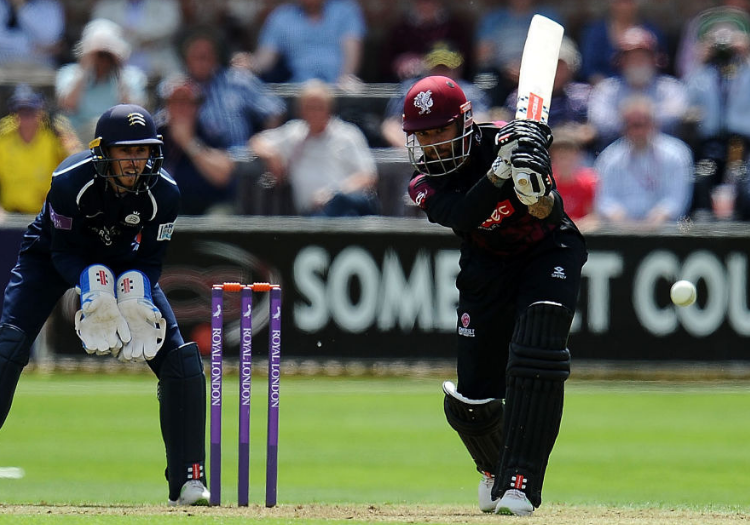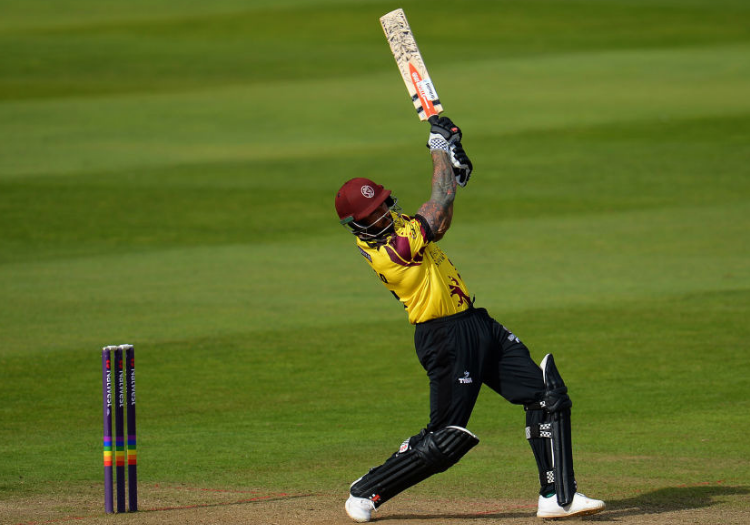The Somerset allrounder explains how to modify your approach in longer and shorter forms
This article first appeared in The Cricketer's Club Cricket Guide - you can read the guide in full HERE!
In Twenty20 Powerplay and death periods, it is pre-determined as a batsman that you are going to hit boundaries. It is not necessarily the batsman’s choice, but it is what the game dictates to him or her.
My job as an opener is to find the fence. I am instantly gripping the bat a lot harder than I would in a four-day game, where I would be looking to block and hit bad balls for four. My gameplan is out the window… now I am thinking in fours and sixes.
So how should club and school cricketers go about a similar role?
My son is playing a lot of junior cricket and I see a trend of dismissals where the ball is hit in there. I see a lot of pretty shots – nice and smooth – but the ball is going in the air and they are getting caught on the boundary.
I think to myself, “if you’re going to play that shot with that level of intensity, just a nice shot, why not hit it along the ground?”
My philosophy is, if you’re going to hit the ball in the air, make it meaningful.

Batting in T20 cricket has become an art in its own right. A growing number of cricketers are dedicating themselves entirely to the shortest format, and the style of batting in it is becoming increasingly specialised.
Plenty of players, if not most, who open or bat in the top order in T20 do not open in red-ball cricket, because the role contrasts so much.
I believe my batting style is perfectly suited to T20 cricket, and here are three key shots in my arsenal:
This is the shot that gives me most pleasure because I think it’s aesthetically the best-looking shot. It’s also the hardest to defend because no off-spinner in their right mind would ever have a fielder out at deep extra cover, so I’m trying to access that position.
It’s very much a lofted off drive that will take me over mid-off, but at the point of impact I’m trying to slightly bring my bottom hand through to create a slice and dip my back leg, and sort of come off the shot.
With a lofted off-drive, my body position would be much more straight on, whereas with this particular shot over extra cover, I’m creating an angle. This means I can get inside-out while still getting a nice contact.
It’s a shot where I’m not trying to hit the ball too hard. It’s a proper cricket shot because it’s all about timing and angles.
I’ve had to develop my offside game quite a bit during my career. One person who helped with that was Stuart Law, who was coach of the Sylhet Royals, the side I was playing for in the first Bangladesh Premier League back in 2012.
If I’m looking to go downtown, as baseball players would say, and there’s an off-spinner landing it on a middle to leg line in order to tuck me up, my ideal position is to go forward into the ball and generate power that way.
I go forward because I want to hit the ball where it’s pitched. I will probably press onto my front leg, I’ll see that it’s short and slower, and I’ll rock onto my back foot, then I just put everything I’ve got through the ball. The transfer of weight is key.
READ MORE: The Cricketer's Club Cricket Guide
However, if they drag the ball down and take pace off it, which a lot of good off-spinners do, this means you can transfer that back and still have that belief that you have the power to hit from the back foot.
It also means you are able to generate loft, but there are a number of different methods you can use to do this.
MS Dhoni uses the helicopter which means he ends up standing on his back foot only, whereas I try to keep myself a little bit more stable. I’m still dropping my back knee though because it allows me to create loft while keeping the bat straight.

It is about belief and full commitment to the shot. If you try to just ding it over them, you’re going to hole out, because it takes a lot of strength. It takes real flat-out power to hit a back-foot shot for six.
Chris Gayle, in particular, does that brilliantly against spinners. He has the ability to rock back and still belt them. He may come across as incredibly chilled – regardless of whether he hits a six or gets out – but he has an ultimate belief in what he’s trying to do.
With all power shots it’s about belief. You have to believe that if you get 60 per cent of the ball, the ground’s not going to be big enough.
This shot is one of my more favoured options against seam bowling because I like running at them. Some people will do a side step where they will tap their feet together as they advance, but I prefer to cross over.
Crossing over means that when I take my first step down and the bowler sees me coming and throws one wide, I can still get out to it. It also means I can open out to the legside as well if need be. I would say it’s a more athletic position than having my feet together.
The point in running at the bowler is that I’m predicting that they are going to try to tuck me up, and I’m looking to change his length to my favour. Once I get there I need to follow it up with a fully committed swing of the bat.

Bringing my back leg through with the shot has the same effect as in golf and tennis – it’s all about the generation of power.
I’ve got these arms which can generate x amount of power, but that pales in comparison to what I can do with my whole body. The big tee shots and big Rafael Nadal backhand slices all come from the whole body.
To perfectly execute this sort of power shot, you should be conscious of how hard you can swing a bat without it adversely affecting your head position.
There’s no way you can make good contact on the ball consistently if you’re swinging wildly – you have to be able to swing your bat in a fashion which means you can still keep it under some level of control.
The man who was really important in me becoming so conscious of balance was someone not known for his big-hitting – Justin Langer.
He referred a lot of things back to the other sports he practised like martial arts, and we would do some drills where he would often flip it back to boxing.
Langer would throw a ball at me, I’d play a shot and he would make me hold the pose and then try to push me in the chest. He was essentially judging how balanced I was by how easy I was to push over.
He brought the mindset in that, if I’m generating the sort of power I can from a position of balance, the consistency of my strikes is going to go through the roof – and they did.